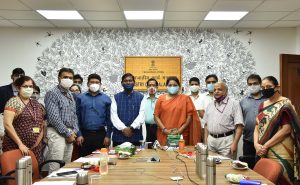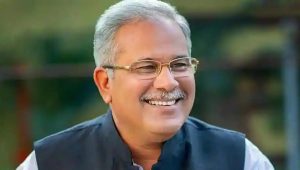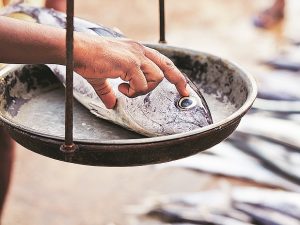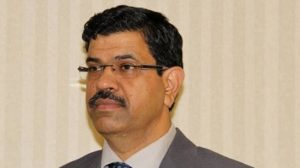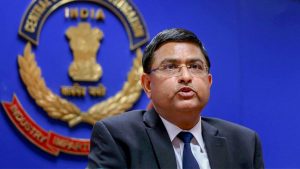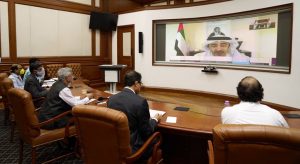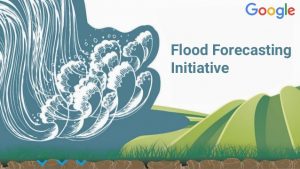VisionIAS
11:19

📰 Time for India and Nepal to make up
The mending of the most exemplary inter-state relationship of South Asia must be as dramatic and rapid as the rupture
•When the Nepal-India dispute over the Himalayan territory of Limpiyadhura flared up in May, New Delhi opinion-makers presented it as the doing of an upstart nation run by a renegade Prime Minister thumbing its nose at India, that too at Beijing’s instigation. Kathmandu’s polity bristled at the accusation and the entire political spectrum came together in nationalist climax to adopt a new map which included Limpiyadhura.
•There has been much blood-letting over the past four months, with one side (India) petulant, the other angry. New Delhi pointedly says it will sit for talks only after the COVID-19 pandemic and some north Indian TV channels have targeted Nepal’s Prime Minister K.P. Oli with revolting coverage. In turn, he abandoned diplomatic decorum to question India’s commitment to ‘satyameva jayate’ and then claimed the true birthplace of Lord Ram was situated in present-day Nepal.
•This tailspin must be halted so that the most exemplary inter-state relationship of South Asia may recover. De-escalation must happen before the social, cultural and economic flows across the open border suffer long-term damage.
Fear of abandonment
•Right off the bat, New Delhi analysts must try and understand why Nepal does not have an ‘independence day’. It would help them in unravelling the Limpiyadhura tangle and accepting the need to go back to the archival papers (and misdemeanours) of the East India Company and the successive Viceroys and Governors General — right down to the imperious present.
•From the Kathmandu perspective, Indian diplomacy seems increasingly unresponsive under the centralised control of the Prime Minister’s Office. As geopolitical capacity dwindled, Indian commentators have returned to lambasting hapless Pakistan while ignoring China, the true would-be adversary.
•With regard to China, New Delhi has nurtured a paralysing paranoia regarding the Himalayan range that goes back to the 1962 debacle, a condition now worsened by the Galwan intrusion. Nepal, Bhutan and India’s own Himalayan tracts are regarded merely as strategic buffers under this ossified policy. In addition, there is the constant preoccupation with neighbours who have supposedly ‘sold out’ to China. A confident nation-state without fear of abandonment would have behaved differently on Limpiyadhura.
•The cause of the chasm that has opened up between Kathmandu and Delhi relates to the disputed ownership of the triangle north of Kumaon, including the Limpiyadhura ridgeline, the high pass into Tibet at Lipu Lek, and the Kalapani area hosting an Indian Army garrison.
•New Delhi’s position on the dispute is based on its decades-long possession of the territory, coupled with Kathmandu’s implied acquiescence through its silence and the omission of Limpiyadhura on its own official maps.
•Nepal’s claim is centred on the Treaty of Sugauli (1815), whose language reads the “Rajah of Nipal renounces all claim to the countries lying to the west of the River Kali”. No agreement has superseded that treaty, and so no subsequent cartographic chicanery by the Company Sarkar or successor governments can undermine the 1815 document. Essentially, Nepal wants to stay with what was considered the upstream Kali at the time of the treaty’s signing 205 years ago.
•While the colonised parts of South Asia have had to deal western surnames that pervade their maps and frontiers, such as Radcliffe, McMahon and Durand, a historically evolved country such as Nepal would tend to rely more on proof of continuous state administration.
•Journalist Bhairab Risal (who celebrated his 93rd birthday on August 13) was the government official conducting the 1953 national census in the Limpiyadhura villages, whose citizens also voted in the first democratic elections of 1959. Land records were kept in Nepal’s district headquarters of Darchula and Baitadi until access was blocked in the 1960s by the Indian base at Kalapani.
•Kathmandu responded with sensitivity to Indian strategic concerns before and after the 1962 China-India war by allowing the Indian army post to be stationed within what was clearly its territory at Kalapani and not publicly demanding its withdrawal. However, following the advent of democracy in 1990, the demand for evacuation of Kalapani gained momentum.
•Kathmandu’s diplomats deny the accusation of passivity over the decades, saying that as the weaker power, Nepal preferred quiet diplomacy and that Kalapani had never been off the table since talks began in the early 1980s. As for the ‘possession’ argument, if control of a disputed region were to confirm ownership, then what of China’s continuous hold over Aksai Chin since Independence? Regarding the suggestion of Nepal acting on China’s ‘behest’, in fact Kathmandu considers China complicit on Lipu Lek, and has lodged strong protests with Beijing regarding its joint plans with New Delhi on use of the high pass.
Road to Lipu Lek
•From the time when a joint communiqué was issued in 1997 during I.K. Gujral’s prime ministership down to the present time of Prime Minister Narendra Modi, the two governments have agreed that a territorial dispute exists on upstream Kali and have assigned negotiators. A border demarcation team was able to delineate 98% of the 1,751 km Nepal-India frontier, but not Susta along the Gandaki flats and the upper tracts of the Kali.
•In 2014, India’s External Affairs Minister Sushma Swaraj agreed to the establishment of a Border Working Group, which was announced by Prime Minister Modi and Prime Minister Sushil Koirala. It too failed to make headway. In August 2019, India’s Minister for External Affairs S. Jaishanker and Nepal’s Minister of Foreign Affairs Pradip Gyawali assigned the task to the two Foreign Secretaries. That was where matters rested, with India dragging its feet on the Foreign Secretaries’ meeting, when things went awry.
•Nepal has been keen to sort out the matter away from the limelight. It was after India published its new political map in November following the bifurcation of Jammu and Kashmir and Ladakh that the pressure arose for Kathmandu to put out its own map incorporating the Limpiyadhura finger. The government cartographers got busy.
•Knowing full well the dangers of taking on the Indian lion, Prime Minister Oli held off on the map release while waiting for New Delhi to come to the table. But diplomacy did not get a chance, with the Ministry of Defence evidently having kept even South Block in the dark until India’s Defence Minister Rajnath Singh, with much fanfare, digitally ‘inaugurated’ the unfinished track to Lipu Lek on May 8.
•Prime Minister Oli’s position became untenable, and he proceeded with the constitutional amendment to certify the new map. Indian diplomats lobbied to keep Nepal’s Parliament from adopting the amendment, but Kathmandu needed it for the sake of cartographic parity with India in future talks.
•Truth be told — that the Limpiyadhura triangle exists now on the maps of both countries should not obstruct negotiations, when you consider that the smaller area of Kalapani, too, has remained on the maps of both countries for decades. And, life has gone on.
Dousing the volcano
•The ice was broken on August 15 when Prime Minister Oli called Prime Minister Modi on the occasion of India’s Independence Day, but that is just the beginning. Talks must be held, for which the video conference facility that has existed between the two Foreign Secretaries must be re-activated.
•Delay will wound the people of Nepal socially, culturally and economically. As the larger country, India may think it will hurt less, but only if it disregards its poorest citizens from Purvanchal to Bihar and Odisha, who rely on substantial remittance from Nepal.
•India does have experience of successfully resolving territorial disputes with Bangladesh, Sri Lanka and even Pakistan bilaterally and through third-party adjudication. Given political will at the topmost level, it should be possible to douse the Limpiyadhura volcano just as quickly as it has erupted.
•One difficulty is the apparent absence of backchannel diplomacy between the two capitals, which helped in ending the 2015 blockade. Today, India’s Prime Minister’s Office exercises such exclusive power that all channels have dried up. The Rashtriya Swayamsevak Sangh leadership might have been approached, but that was the very category Prime Minister Oli riled with his Ayodhya-in-Nepal claim.
•There is an immediate need to de-escalate and compartmentalise. The first requires verbal restraint on the part of Prime Minister Oli and India’s willingness to talk even as the pandemic continues. While India’s Foreign Office has thankfully remained restrained in its statements, India is required to maintain status quo in the disputed area. This means halting construction on the Lipu Lek track, which is the immediate cause of the present crisis.
•With the Prime Ministers setting the tone, the negotiating teams must meet with archival papers, treaties and agreements, administrative records, communications, maps and drawings. The formal negotiations should begin with ab initio public commitment by both sides to redraw their respective maps according to the negotiated settlement as and when it happens.
•Not to prejudge the outcome, if Nepal were to gain full possession of Limpiyadhura, it should declare the area a ‘zone of peace and pilgrimage’. The larger area must be demilitarised by both neighbours to ensure security for themselves, while the Kailash-Manasarovar route is kept open for pilgrims. The idea is certainly worth a thought: a Limpiyadhura Zone of Peace and Pilgrimage.


